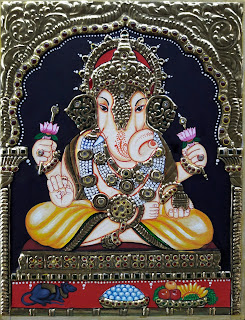TANJORE PAINTING
History
Thanjavur and worked under the patronage of the Thanjavur Nayakas. Subsequently, the Maratha rulers who defeated the Thanjavur Nayakas began to nurture the Thanjavur atelier. Needless to say, the artists absorbed the local influences and the individual tastes of their Maratha patrons which helped evolve the unique Thanjavur style of painting.
Vijayanagara Rayas
The Vijayanagar empire, founded by Harihara and Bukka, was for long a bulwark against the rapidly advancing Islamic influence from the nearby Deccan and the farther North. While the foreign influences did gradually percolate into the Peninsular South, the Vijayanagar empire ensured that the older Hindu artistic traditions were protected and preserved.
Thanjavur Nayakas
The Vijayanagar Rayas administered their vast kingdom through Nayaka Governors who also administered the outlying provinces or states under the supervision of the Raya.
Achyutappa was succeeded by his son Raghunatha Nayaka who in turn was succeeded by Vijayaraghava Nayaka. Raghunatha, who was possibly the most successful Thanjavur Nayaka ruler, was also a great patron of art and artists and helped establish the unique school of Thanjavur artists who later evolved the Thanjavur style of paintings under the Marathas.
Marathas
Due to internal dissensions in the Nayaka line, Ekoji otherwise called Venkoji (1676–83), half-brother of Chatrapati Shivaji marched into Thanjavur on behalf of the Adil Shah of Bijapur under whom he was a General. He subsequently captured Thanjavur and established the Maratha rule.
Style and Technique
Paintings in addition to being done on canvas, were also done on walls, wooden panel, glass, paper, mica and exotic media such as ivory. Small Ivory portraits were typically worn as cameo pendants called rajaharam and were quite popular.
The shading in Thanjavur art was more to create a feeling of depth than to conform to the European conventions of lighting and perspective.
Tanjore and Mysore paintings
Tanjore and Mysore paintings, both spring from the same source - Vijayanagara paintings to begin with and Nayaka paintings subsequently. The very same artists, Chitragars and Naidus migrated to various places including Thanjavur and Mysore.
In Mysore paintings, the jewellery, costumes, architectural features, furniture, etc. reflect the contemporary style prevalent in the Mysore Palace.
Tanjore paintings in Company style
The British Museum and The Victoria and Albert Museum have an enviable collection of such paintings.
The paintings were usually executed on European paper, without gesso work, little or no Gold foil and without any glass or gem inlay.
www.tmpooja online shopping.com
Our Other Topics:
- NEEM FLOWER USES & BENEFITS
- ROSE HERBAL BENEFITS & SKIN CARE
- USES OF HENNA AND HOW TO USE IT ON HAIR
- TANJORE GLASS PAINTINGS & ARTS
- HOW TO SHINE AND CLEAN BRASS ITEMS AT HOME ?
























No comments:
Post a Comment